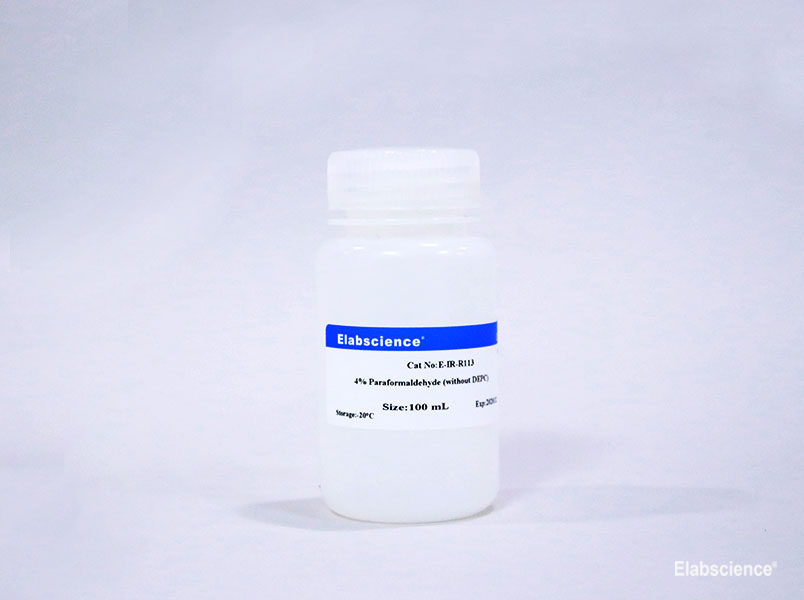Introduction
4% Paraformaldehyde
tissue fixation solution is widely used in the detection of tissue, tissue
slice, cell and other biological sample fixation solutions such as
immunohistochemistry (IHC), immunofluorescence (IF), immunocytochemistry (IC),
flow cytometry (FACS). This product is prepared in PBS solution and can be
directly used for tissue or cell fixation without dilution. If a lower
concentration of paraformaldehyde is needed, PBS can be used as dilution buffer.
4% Paraformaldehyde
tissue fixation solution has strong penetrability and fixation, which can make
the tissue harden and it is good for slicing. It will cause less tissue
shrinkage, less damage and mild, which can well preserve the inherent substance
and maintain the antigenicity and fine structure of the tissue. In addition, 4%
Paraformaldehyde can be used to fix and preserve fat and lipid substances.
This product
has good fixation effect and wide applications. It is suitable for the fixation
of various common cells or tissues. It has good fixation effect on skin,
muscle, viscera, etc. It mainly acts on protein, but can’t fix uric acid and
sugar, etc.
This product
does not contain DEPC and it is not recommended for in situ hybridization or
other experiments requiring detection of nucleic acids.
It is
recommended that 1 ml of fixed solution is needed for each sample fixation.
Components
|
Cat.
|
Products
|
100 mL
|
500 mL
|
1000 mL
|
Storage
|
|
E-IR-R113
|
Tissue Fixation Solution / 4%
Paraformaldehyde (without DEPC)
|
100
mL
|
500
mL
|
500
mL×2
|
-20°C
|
Experimental Procedure
1. For
Cell Samples
1)Remove
the culture medium, add 1 ml 4% Paraformaldehyde tissue fixation solution to
one hole of each six-hole plate.
2) For
other cell samples such as cell smear, add appropriate amount of 4% Paraformaldehyde
tissue fixation solution to cover the sample fully.
3) It
is recommended to fix at room temperature for 10~20 min, or for a long time,
such as 1~2 h.
4) Wash
the cells to remove residual paraformaldehyde.
2.For
Tissue Slices
1) Add
4% Paraformaldehyde tissue fixation solution to cover the slice fully.
2) It
is recommended to fix at room temperature for 10~20 min, and it can be fixed
for a long time such as 1~2 h when the slice is thick.
3) Wash
the slices to remove residual paraformaldehyde.
3. For
Tissue Block Samples
1) Immerse
the tissue in 4% Paraformaldehyde tissue fixation solution and fix it at room
temperature or 4°C for 2~24 h.
2) It
is recommended to fix the tissue in 8 h, unless the tissue block is too large
to penetrate.
3) Put
the tissue into a centrifugal pipe with distilled water for cleaning, and
change the water every 15~30 min for 6~8 times.
4) It
is recommended to rinse in a shaker or rinse with running water for 1~2 h.
5) Gradient
dehydration and embedding.
Tip: If the tissue is not to be prepared as paraffin embedded tissue
in time, please store the tissue in 70~75% alcohol.
Storage
Store
at -20°C for 12 months.
Cautions
1. If the product is stored for a
long time, the aldehyde group may be oxidized to acid, which will reduce the pH
of the solution, thus will affect the subsequent staining.
2. Different cell or tissue
samples need different fixation time. The fixation time should be adjusted
according to the type of cell or tissue and the size of tissue block.
3. Although the effect of 4% Paraformaldehyde tissue fixation
solution is mild, it may harden the tissue. If the
fixation time is too long, the tissue will become brittle and fragile.
Therefore, the fixation time should not exceed 24 hours.
4. Polyoxymethylene can exist in
the fixed cell or tissue samples for a long time. There will still be residues
after washing with appropriate detergent or water for several hours. Therefore,
the subsequent experimental results are easy to be affected by aldehyde group,
and the residual polyoxymethylene must be washed away as much as possible.
5. 4% Paraformaldehyde tissue fixation solution fix the cells or tissue samples need to be repaired before
immunostaining or other subsequent operations.
6. This product is harmful to
human body. Please be careful during operation and pay attention to effective
protection to avoid direct contact with human body or inhalation.
7. This product is for research
use only. It couldn’t be used for clinical diagnosis or treatment, food or
medicine, and can’t be stored in residence.
8. For your safety and health,
please wear the lab coat and disposable gloves before the experiments.










